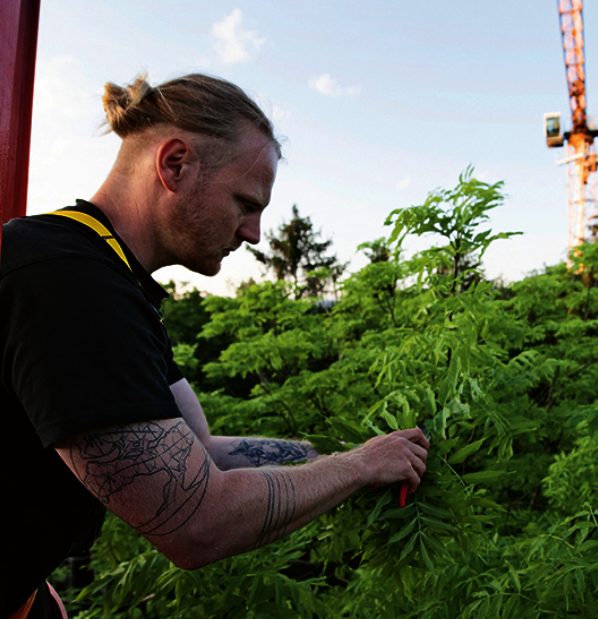Research Interest
The overall theme = Water + Wood
The summer of 2018, and more recently 2022, illustrates that European forests are exposed to increasingly drier and warmer climatic conditions. There is thus a recognizable need for better understanding how different tree species will cope with present and future drying and warming, as these forests are providing essential ecosystem services to society. As a tree physiologist, my main research interest involves unravelling the interplay between forests and the Earth’s climate system. During my scientific career I moved from advancing analyses of annual tree-growth patterns in relation to (a)biotic drivers, covering tropical, temperate and alpine forests, to pushing the boundaries of mechanistic approaches for explaining transpiration and wood formation on finer time scales. This “shift” convinced me that we need more insight into the water-related physiological mechanisms driving carbon assimilation by leaves and allocation into tree growth, in order to better understand climate-growth interactions. Such insights will allow me to support science-based forest management decisions and help us to guide conservation actions aiming to enhance forest ecosystem resilience in the face of climate change.
My work at the Physiological Plant Ecology group involves improving the understanding of the drought sensitivity and acclimation potential of European tree species in the large-scale ecosystem manipulation experiment at the Swiss Canopy Crane II site. I utilize an exciting interdisciplinary combination of dendrochronology, wood anatomy, and ecophysiology to assess the coupling between water availability and wood formation. For the tree-water relations, I employ modern quantitative wood anatomical techniques, high-resolution sap flow sensors/dendrometers, and classical ecophysiological measurements (e.g., gas exchange and water potentials). I also engage in developing cutting-edge models to explore mechanistic relations between drought and wood formation by combining highly temporally resolved growth, carbon, and water use observations from a wide range of natural forests, including the understudied tropical biome.
Main Research Topics
- Tree physiology
- Xylem formation
- Hydraulic functioning
- Forest monitoring networks
- Mechanistic whole-tree modelling
Education and Professional Experience
since 2021 Postdoctoral Researcher, Physiological Plant Ecology group, University of Basel, CH
2021 - 2021 Postdoctoral Researcher, Gembloux Agro-Bio, University of Liège, BE
2019 - 2021 SNSF Postdoctoral Fellow, Laboratory of Plant Ecology, Ghent University, BE
2018 - 2019 Postdoctoral Researcher, Forest Dynamics, Swiss Federal Research Institute for Forest, Snow and Landscape Research WSL, CH
2014 - 2018 PhD in Botany, University of Basel, Department of Environmental Sciences, CH
2012 - 2014 Visiting Researcher, Forest Ecology and Management group, Wageningen University and Research, NL
2009 - 2012 MSc in Environmental Science, Utrecht University, NL
2009 - 2006 BSc in Biology, Utrecht University, NL
Key Publications
Peters RL, Steppe K, Pappas C, Zweifel R, …, Kahmen A. 2023. Daytime stomatal regulation in mature temperate trees prioritizes stem rehydration at night. New Phytologist
Salomon RL, Peters RL*, Zweifel R, Sass-Klaassen U, Lerink BJW, …, Steppe K. 2022. The 2018 European heatwave led to stem dehydration but not to consistent growth reductions in forests. Nature Communications13: 28. *equally contributing first author
Hurley AG, Peters RL, Pappas C, Steger DN, Heinrich I. 2022. Addressing the need for interactive, efficient, and reproducible data processing in ecology with the datacleanr R package. PLOS ONE17: e0268426.
Peters RL, Steppe K, Cuny HE, de Pauw DJW, Frank DC, …, Fonti P. 2021. Turgor ‐ a limiting factor for radial growth in mature conifers along an elevational gradient. New Phytologist229: 213–229.
Babst F, Friend A, Karamichalaki M, Wei J, von Arx G, Papale D, Peters RL. 2021. Modelling ambitions outpace observations of forest carbon allocation. Trends in Plant Science3: 210–219.
Peters RL, Pappas C, Hurley AG, Poyatos R, Flo V, Steppe K. 2021. Assimilate, process and analyse thermal dissipation sap flow data using the TREX R package. Methods in Ecology and Evolution12: 342–350.
Huang JG, Ma Q, Rossi S, Biondi F, Deslauriers A, Fonti P, …, Peters RL, …, Ziaco E. 2020. Photoperiod and temperature as dominant environmental drivers triggering secondary growth resumption in Northern Hemisphere conifers. PNAS117: 20645–20652.
Peters RL, Speich M, Pappas C, Kahmen A, von Arx G, …, Fonti P. 2019. Contrasting stomatal sensitivity to temperature and soil drought in mature alpine conifers. Plant, Cell & Environment42: 1674–1689.
Peters RL, Fonti P, Frank DC, Poyatos R, Pappas C, …, Steppe K. 2018. Quantification of uncertainties in conifer sap flow measured with the thermal dissipation method. New Phytologist219: 1283–1299.
Peters RL, Groenendijk P, Vlam M, Zuidema PA. 2015. Detecting long-term growth trends using tree rings: a critical evaluation of methods. Global Change Biology 21: 2040–2054.

